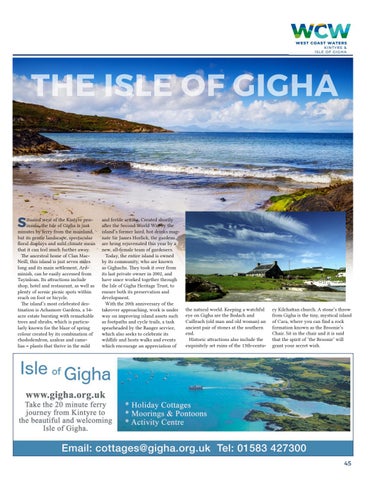THE ISLE OF GIGHA
S
ituated west of the Kintyre peninsula, the Isle of Gigha is just minutes by ferry from the mainland, but its gentle landscape, spectacular floral displays and mild climate mean that it can feel much further away. The ancestral home of Clan MacNeill, this island is just seven miles long and its main settlement, Ardminish, can be easily accessed from Tayinloan. Its attractions include shop, hotel and restaurant, as well as plenty of scenic picnic spots within reach on foot or bicycle. The island’s most celebrated destination is Achamore Gardens, a 54acre estate bursting with remarkable trees and shrubs, which is particularly known for the blaze of spring colour created by its combination of rhododendron, azaleas and camelias – plants that thrive in the mild
and fertile setting. Created shortly after the Second World War by the island’s former laird, hot drinks magnate Sir James Horlick, the gardens are being rejuvenated this year by a new, all-female team of gardeners. Today, the entire island is owned by its community, who are known as Gighachs. They took it over from its last private owner in 2002, and have since worked together through the Isle of Gigha Heritage Trust, to ensure both its preservation and development. With the 20th anniversary of the takeover approaching, work is under way on improving island assets such as footpaths and cycle trails, a task spearheaded by the Ranger service, which also seeks to celebrate its wildlife and hosts walks and events which encourage an appreciation of
the natural world. Keeping a watchful eye on Gigha are the Bodach and Cailleach (old man and old woman) an ancient pair of stones at the southern end. Historic attractions also include the exquisitely set ruins of the 13th-centu-
ry Kilchattan church. A stone’s throw from Gigha is the tiny, mystical island of Cara, where you can find a rock formation known as the Broonie’s Chair. Sit in the chair and it is said that the spirit of ‘the Broonie’ will grant your secret wish.
45




























